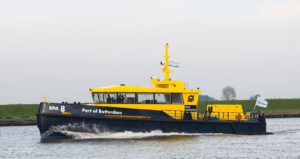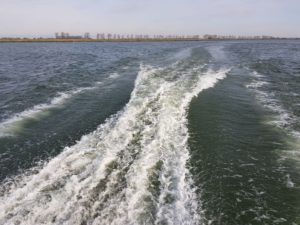RPA 8 shows exceptional efficiency at river trials
Shipyard Kooiman conducted river trials this week on the RPA 8, the new patrol vessel of the Port of Rotterdam. The 25 m boat marks a big step in naval architecture for such vessels, combining Van Oossanen Naval Architects’ Fast Displacement Hull Form (FDHF) with an underwater spoiler, called Hull Vane®. The ship will consume less than 60% of her predecessors to carry out the same tasks.
Niels Moerke, managing director of Van Oossanen and Hull Vane BV: “Fast vessels need some form of lift in the aft ship to be efficient at high speeds. You can generate this lift with the hull, by creating a hard chine planing hull form, or with hull appendages such as interceptors and trim wedges. In our experience however, the most efficient way to create this lift is with a submerged wing at the transom. This allows us to design the vessel to be much more efficient at the cruising speed of 20 km/h, while still achieving a maximum speed of 35 km/h.” The stern-mounted wing is basically a hydrofoil for displacement ships, a patented product called Hull Vane® and on the market since 2014. It reduces the stern wave and develops forward thrust. Model tests at Marin showed that the Hull Vane® saves over 20% in fuel consumption from 20 to 35 km/h on RPA 8.
What is most striking onboard is that there is no noticeable difference between sailing at 15, 25 or 35 km/h. Due to its FDHF hull shape and the Hull Vane® there is no “hump speed”, and the speed can be chosen freely depending on the need. There is also a very minimal generated wave pattern at all speeds. Due to her efficiency and a number of noise-reducing measures, RPA 8 is an exceptionally quiet boat. She has 40% less engine power than her colleagues RPA 1 and RPA 2. At 95% power, the measured noise level in the wheelhouse was only 49 dB(A), which is what you normally experience at home. The fuel consumption at 20 km/h is only 26 litres per hour.
Manouvring trials were done, showing that RPA 8 is extremely manoeuvrable. For slow-speed manouvring, she is helped by her controllable pitch propellers, her rudders with a maximum angle of 60 degrees and a powerful bow thruster. RPA 8 has a hybrid propulsion installation, allowing her to run both propellers and all electrical consumers from just one – properly loaded – main engine during patrolling.
Niels Moerke: “RPA 8 is a good example of what can be achieved when a ship is designed for efficiency over the entire operational profile. We congratulate Shipyard Kooiman on building such a quality vessel and the Port of Rotterdam for their courage to embrace new technology, which will massively reduce CO2 emissions. We hope to retrofit a Hull Vane® also to similar existing ships.” RPA 8 is the eighth vessel to be equipped with a Hull Vane®, and ten other ships which will have a Hull Vane® are currently under construction.


Wave profile at maximum speed